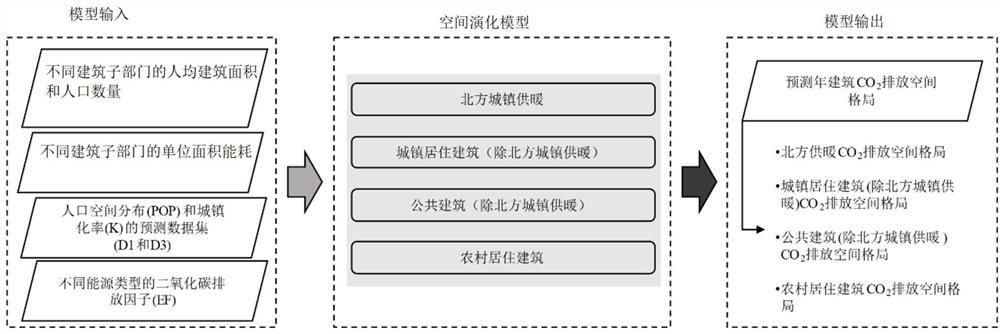A method and system for predicting building carbon dioxide emissions
A technology of carbon dioxide and buildings, applied in the field of prediction method and system of carbon dioxide emissions of buildings, can solve the problems of unable to screen typical areas of building carbon dioxide, unable to reflect time-space differences and deviations of carbon dioxide emissions, etc.
- Summary
- Abstract
- Description
- Claims
- Application Information
AI Technical Summary
Problems solved by technology
Method used
Image
Examples
Embodiment Construction
[0105] The present invention will be further described in conjunction with accompanying drawing and example now.
[0106] Such as figure 1 As shown, the present invention provides a method for predicting building carbon dioxide emissions. In the modeling process, the top-down and bottom-up methods are combined, and the established spatial evolution model is used to estimate building carbon dioxide emissions. , taking full account of the energy development trends and characteristics of new buildings and existing buildings, it can more effectively reveal the temporal and spatial differences of carbon dioxide emissions in different sub-sectors of buildings.
[0107] The estimation results output by the spatial evolution model can simultaneously identify the temporal and spatial heterogeneity of building carbon dioxide emissions, help to screen out typical areas of building carbon dioxide emissions, and propose more targeted emission reduction targets. At the spatial grid level, ...
PUM
 Login to View More
Login to View More Abstract
Description
Claims
Application Information
 Login to View More
Login to View More - R&D
- Intellectual Property
- Life Sciences
- Materials
- Tech Scout
- Unparalleled Data Quality
- Higher Quality Content
- 60% Fewer Hallucinations
Browse by: Latest US Patents, China's latest patents, Technical Efficacy Thesaurus, Application Domain, Technology Topic, Popular Technical Reports.
© 2025 PatSnap. All rights reserved.Legal|Privacy policy|Modern Slavery Act Transparency Statement|Sitemap|About US| Contact US: help@patsnap.com



